» posted on Monday, September 12th, 2022 by Linda Lou Burton
Hurry Up and Wait
Linda Lou Burton posting from Sweetwaters Serena Camp, Ol Pejeta Conservancy, Nanyuki, Kenya – Hurry up and wait! That’s what you do, when you’re on a trip, especially  when it’s planned by somebody else. Wait for instructions. Hurry to be on time. Then wait for everyone else to show up. Keep looking back to see what you forgot. Blink a lot. Meet the guide. Meet the gang. Check out. Where is our
when it’s planned by somebody else. Wait for instructions. Hurry to be on time. Then wait for everyone else to show up. Keep looking back to see what you forgot. Blink a lot. Meet the guide. Meet the gang. Check out. Where is our 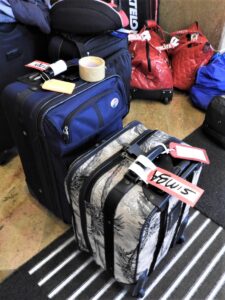 luggage? Which van do we get in? And that was just the beginning of our last day in Nairobi.
luggage? Which van do we get in? And that was just the beginning of our last day in Nairobi.
Our Monday morning wake-up call: 5:30 AM. Take turns in the bathroom; clothes laid out the night before, in order. Who could think, so early? Money belt with passport inside the first thing to put on, shoes the last. Who could eat so early? But we did. We had an organizational meeting at 7:00; notice given the night before that we were LEAVING TOWN by 8:00.
Of course we didn’t. In a room near the lobby we met Abdi, our Safari Guide. ABDI! Our Leader, our Teacher, our Troubleshooter, our Pit Boss for the next weeks. Our Expert-on-Africa. He went over the rules, the plans, the expectations. He introduced our drivers. DANIEL, our driver from yesterday, well yea, Rick and I were pleased about that. FRANK, a tall, humorous young man who stood up to say “I’m not Sinatra!” Then introductions around the circle: Otis and Venita (from Texas); Mike and Lois (from Texas); Judy (from Texas). Ed and Maureen broke the streak – they claimed Kentucky as home; Rick Washington; me Arkansas. I was the oldest in the 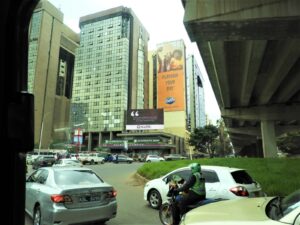
 group. “Have Cane, Will Travel,” I said.
group. “Have Cane, Will Travel,” I said.
Out front, confusion. My bag was tagged SIMBA, to match the picture of the lion taped to the window of our 4×4. We were blurry, confused, scrambling for seats. And then we were gone! It was 8:49 as we headed out the guarded gate of the Nairobi Serena. Downtown we passed under the freeway, turned on A2 by the Co-operative Bank (is there an un-cooperative bank?). Morning traffic rush, cars headed in, matatus (those vividly decorated private buses) whizzing out, cattle marching along the edge. I’d studied the maps months earlier so I’d know what to expect once we left the city.
I knew it was 130 miles to Sweetwaters Serena, our first tent-camp. A 4-hour drive, according to Google. I had my list of towns we’d pass through, how fun, I thought, to see the countryside!
- RUIRU. Population 490,120. Altitude 5,135 feet. Once a coffee-growing area; now mostly housing.
- THIKA. Population 279,429. Altitude 5,351 feet. A major commercial hub. Ol Donya Sabuk National Park near.
- MURANGA. Population 110,000. Altitude 4,120 feet. Traders and farmers here; a busy matatu terminal.
- SAGANA. Population 13,000. Altitude 5,450 feet. Tourist attractions along the Sagana River.
- KARATINA. Population 6,852. Altitude 6,129 feet. Largest open-air market in Kenya. Residents 90% Kikuyu.
- NANYUKI. Population 49,233. Altitude 6,250 feet. On the Equator, the base for people climbing Mt Kenya.
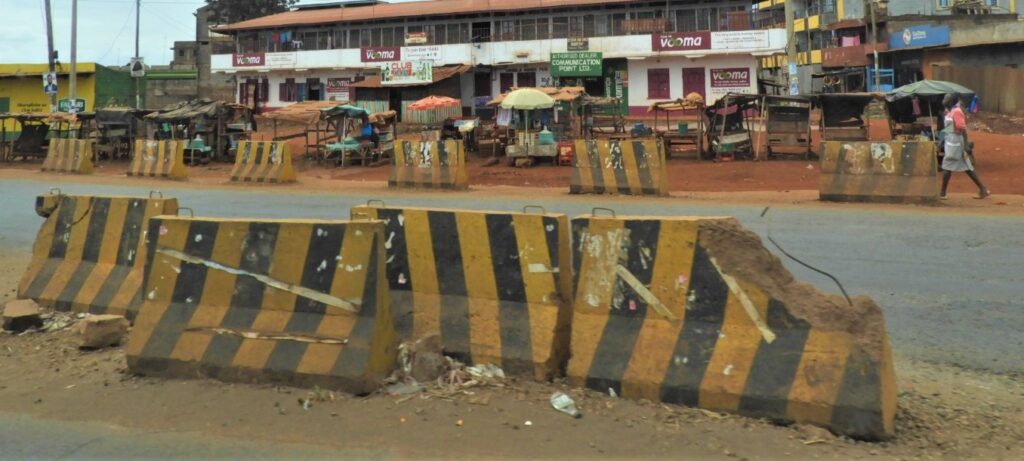 Now here is where expectations met reality. A2 was bumpy, dusty, rigged with speed bumps at every commercial spot. “The Sleeping Police,” Daniel explained to us as he slowed. Again, and again, and again. I clung to the strap, I was third row back in the 4×4 and my seat belt kept slipping. I banged my head against the window; tried to focus on the passing scene.
Now here is where expectations met reality. A2 was bumpy, dusty, rigged with speed bumps at every commercial spot. “The Sleeping Police,” Daniel explained to us as he slowed. Again, and again, and again. I clung to the strap, I was third row back in the 4×4 and my seat belt kept slipping. I banged my head against the window; tried to focus on the passing scene.
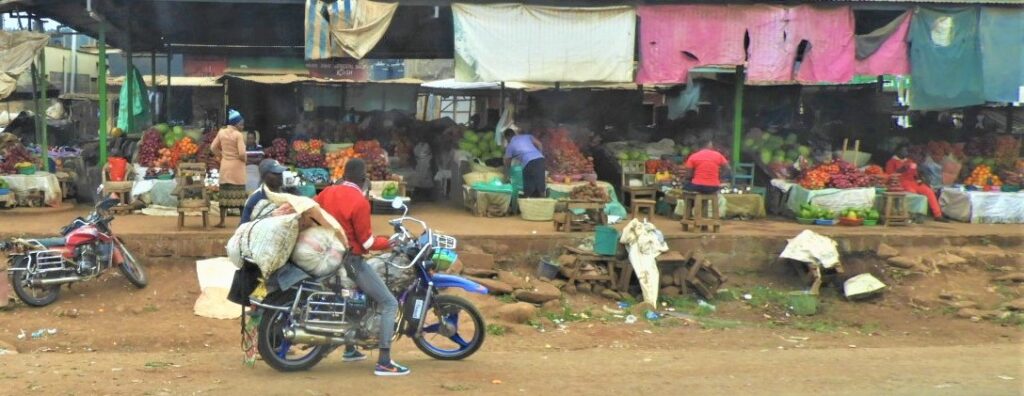 The markets were busy, swarming with people, motorbikes, bananas, tomatoes, melons, produce of every kind. There was commerce going on; action, color, noise. Inside our vehicle, Abdi called our attention to points of interest — the Teachers College, the river, the papaya trees. “Wow!” was repeated, endlessly, by one of our gang. “Wow!” to the Teachers College. “Wow!” to the river. “Wow!” to the papaya trees. I got a headache.
The markets were busy, swarming with people, motorbikes, bananas, tomatoes, melons, produce of every kind. There was commerce going on; action, color, noise. Inside our vehicle, Abdi called our attention to points of interest — the Teachers College, the river, the papaya trees. “Wow!” was repeated, endlessly, by one of our gang. “Wow!” to the Teachers College. “Wow!” to the river. “Wow!” to the papaya trees. I got a headache.
 A short stop at a souvenir shop. I didn’t want to shop. Daniel brought me a chair and a coke while the others bartered for elephants carved out of wood and paintings that would roll up for shipping (we can ship anything direct to your house). Finally, (finally!) back on the road; the scene more rural now; simple roadside stands and fertile farmland.
A short stop at a souvenir shop. I didn’t want to shop. Daniel brought me a chair and a coke while the others bartered for elephants carved out of wood and paintings that would roll up for shipping (we can ship anything direct to your house). Finally, (finally!) back on the road; the scene more rural now; simple roadside stands and fertile farmland.
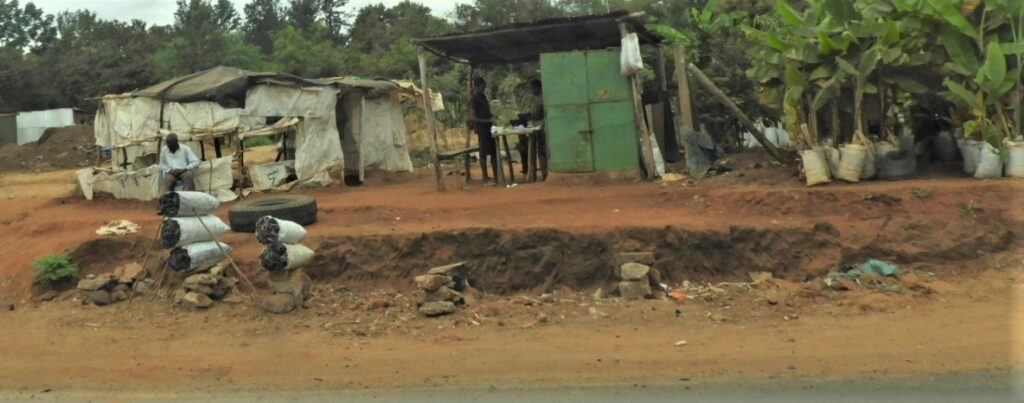 We passed small family plots with tin-roofed barns; we passed huge open fields stretching for miles towards Mt Kenya in the east. We passed Maisha Flour Mills, with its giant grain silos. I asked Abdi about the main products that come out of Kenya; the answer surprised me — concrete, flowers, wheat.
We passed small family plots with tin-roofed barns; we passed huge open fields stretching for miles towards Mt Kenya in the east. We passed Maisha Flour Mills, with its giant grain silos. I asked Abdi about the main products that come out of Kenya; the answer surprised me — concrete, flowers, wheat.
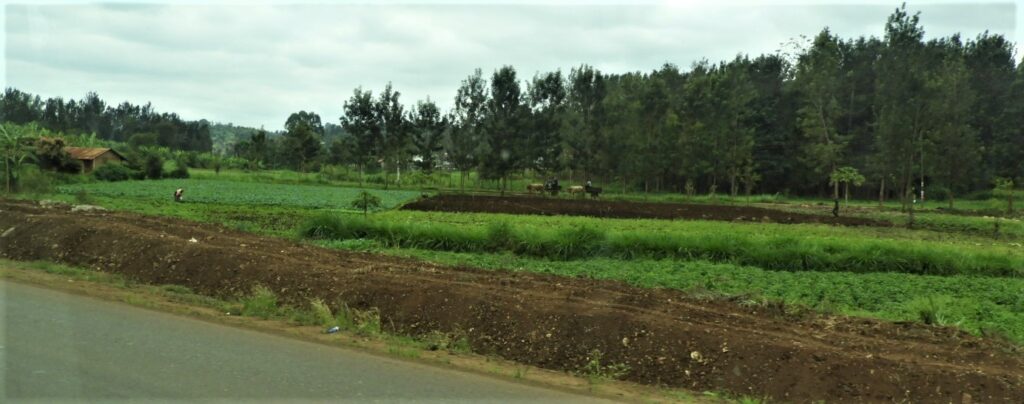 And then we were in Nanyuki; a big yellow sign splashed out the news: You Are At The Equator! We begged to stop; but it was almost 1:30 then, and lunch was waiting at the camp. “We’ll get pictures on the Equator tomorrow,” Abdi promised.
And then we were in Nanyuki; a big yellow sign splashed out the news: You Are At The Equator! We begged to stop; but it was almost 1:30 then, and lunch was waiting at the camp. “We’ll get pictures on the Equator tomorrow,” Abdi promised.
 Daniel made a left onto Nanyuki-Marura Road. It was lined with tiny shops; a hardware store (Sand Blast & Ndarugo?); corrugated housing in a row, chickens wandering out front.
Daniel made a left onto Nanyuki-Marura Road. It was lined with tiny shops; a hardware store (Sand Blast & Ndarugo?); corrugated housing in a row, chickens wandering out front.
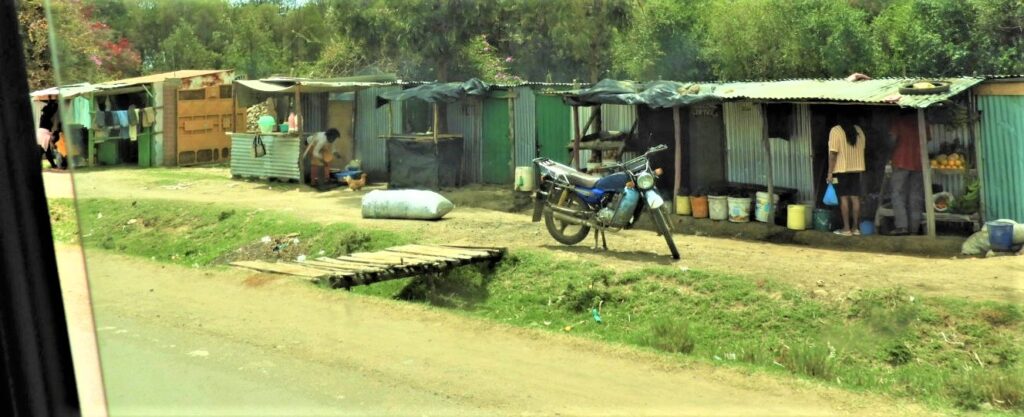 It was 1:49 when we reached Ol Pejeta Conservancy, where our tented camp was located. You’d better keep reading my posts, because this place is going to knock your socks off.
It was 1:49 when we reached Ol Pejeta Conservancy, where our tented camp was located. You’d better keep reading my posts, because this place is going to knock your socks off.
Some things are absolutely worth the wait.

